YAMAHA XENTER 125 2016 Owner's Guide
Manufacturer: YAMAHA, Model Year: 2016, Model line: XENTER 125, Model: YAMAHA XENTER 125 2016Pages: 84, PDF Size: 1.88 MB
Page 31 of 84

For your safety – pre-operation checks
4-2
1
2
345
6
7
8
9
10
11
12
Rear brake Check operation.
Lubricate cable if necessary.
Check lever free play.
Adjust if necessary. 6-20, 6-21
Throttle grip Make sure that operation is smooth.
Check throttle grip free play.
If necessary, have Yamaha dealer adjust th
rottle grip free play and lubricate cable
and grip housing. 6-17, 6-24
Control cables Make sure that operation is smooth.
Lubricate if necessary. 6-23
Wheels and tires Check for damage.
Check tire condition and tread depth.
Check air pressure.
Correct if necessary. 6-18, 6-20
Brake levers Make sure that operation is smooth.
Lubricate lever pivoting points if necessary. 6-24
Centerstand Make sure that operation is smooth.
Lubricate pivot if necessary. 6-24
Chassis fasteners Make sure that all nuts, bolts and screws are properly tightened.
Tighten if necessary. —
Instruments, lights, signals
and switches Check operation.
Correct if necessary.
—
ITEM CHECKS PAGE
U53BE1E0 2 ページ 2015年9月15日 火曜日 午後1時48分
Page 32 of 84
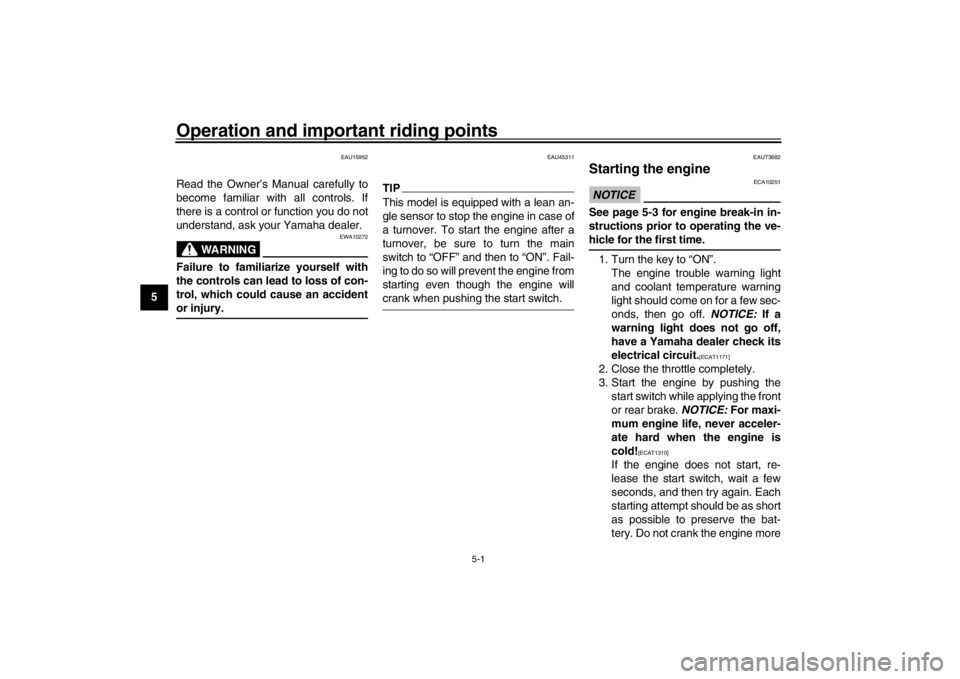
5-1
1
2
3
45
6
7
8
9
10
11
12
Operation and important riding points
EAU15952
Read the Owner’s Manual carefully to
become familiar with all controls. If
there is a control or function you do not
understand, ask your Yamaha dealer.
WARNING
EWA10272
Failure to familiarize yourself with
the controls can lead to loss of con-
trol, which could cause an accidentor injury.
EAU45311
TIPThis model is equipped with a lean an-
gle sensor to stop the engine in case of
a turnover. To start the engine after a
turnover, be sure to turn the main
switch to “OFF” and then to “ON”. Fail-
ing to do so will prevent the engine from
starting even though the engine willcrank when pushing the start switch.
EAUT3682
Starting the engineNOTICE
ECA10251
See page 5-3 for engine break-in in-
structions prior to operating the ve-hicle for the first time. 1. Turn the key to “ON”. The engine trouble warning light
and coolant temperature warning
light should come on for a few sec-
onds, then go off. NOTICE: If a
warning light does not go off,
have a Yamaha dealer check its
electrical circuit.
[ECAT1171]
2. Close the throttle completely.
3. Start the engine by pushing the start switch while applying the front
or rear brake. NOTICE: For maxi-
mum engine life, never acceler-
ate hard when the engine is
cold!
[ECAT1310]
If the engine does not start, re-
lease the start switch, wait a few
seconds, and then try again. Each
starting attempt should be as short
as possible to preserve the bat-
tery. Do not crank the engine more
U53BE1E0 1 ページ 2015年9月15日 火曜日 午後1時48分
Page 33 of 84
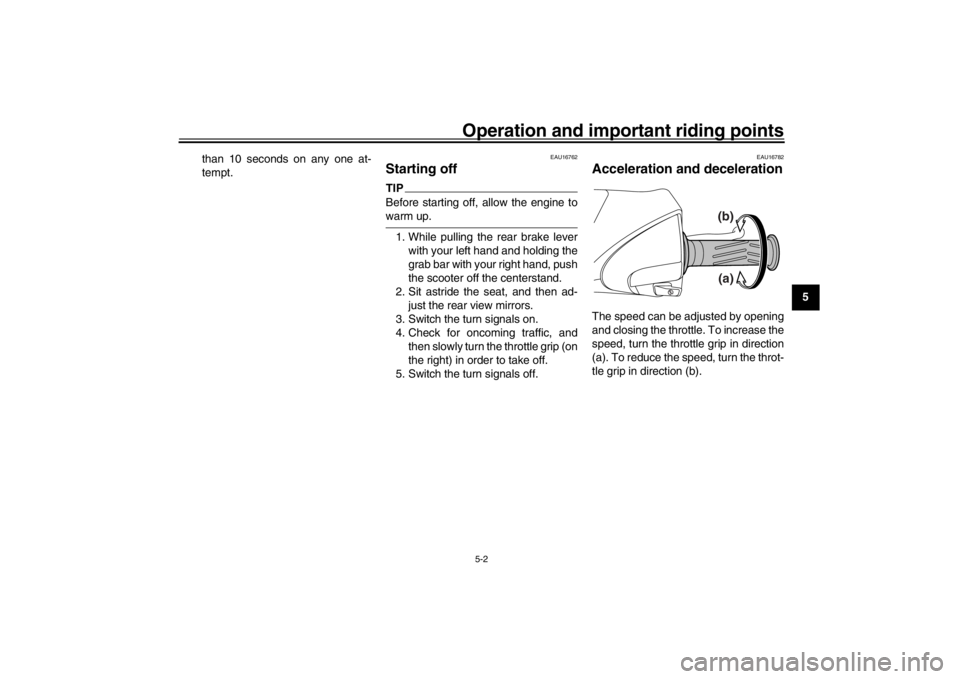
Operation and important riding points
5-2
1
2
3
456
7
8
9
10
11
12
than 10 seconds on any one at-
tempt.
EAU16762
Starting offTIPBefore starting off, allow the engine towarm up.
1. While pulling the rear brake lever with your left hand and holding the
grab bar with your right hand, push
the scooter off the centerstand.
2. Sit astride the seat, and then ad- just the rear view mirrors.
3. Switch the turn signals on.
4. Check for oncoming traffic, and then slowly turn the throttle grip (on
the right) in order to take off.
5. Switch the turn signals off.
EAU16782
Acceleration and decelerationThe speed can be adjusted by opening
and closing the throttle. To increase the
speed, turn the throttle grip in direction
(a). To reduce the speed, turn the throt-
tle grip in direction (b).
(a)
(b)
U53BE1E0 2 ページ 2015年9月15日 火曜日 午後1時48分
Page 34 of 84
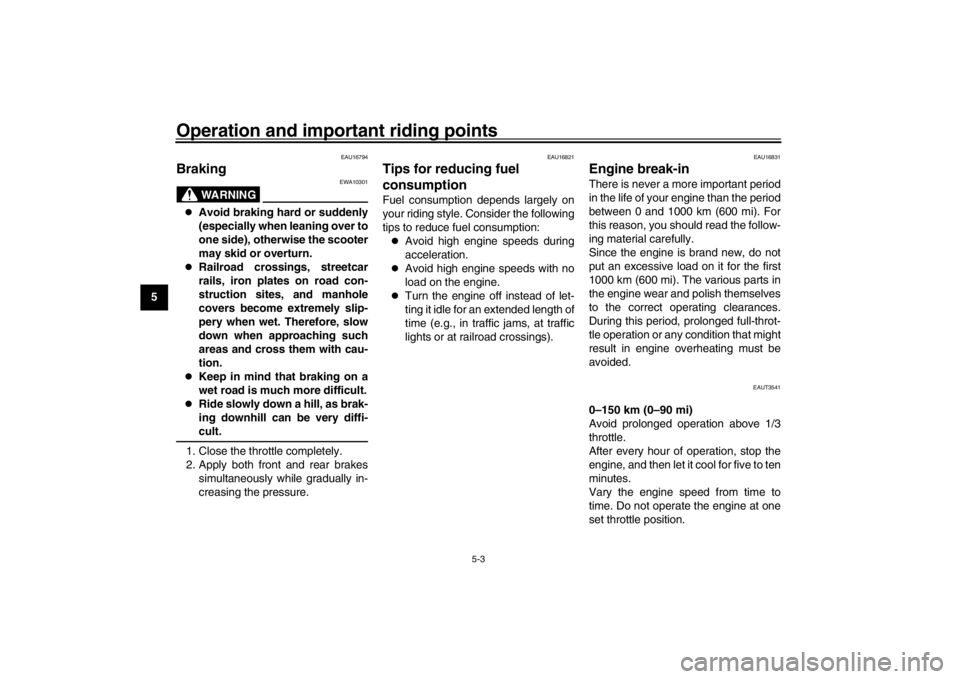
Operation and important riding points
5-3
1
2
3
45
6
7
8
9
10
11
12
EAU16794
Braking
WARNING
EWA10301
Avoid braking hard or suddenly
(especially when leaning over to
one side), otherwise the scooter
may skid or overturn.
Railroad crossings, streetcar
rails, iron plates on road con-
struction sites, and manhole
covers become extremely slip-
pery when wet. Therefore, slow
down when approaching such
areas and cross them with cau-
tion.
Keep in mind that braking on a
wet road is much more difficult.
Ride slowly down a hill, as brak-
ing downhill can be very diffi-cult.
1. Close the throttle completely.
2. Apply both front and rear brakes simultaneously while gradually in-
creasing the pressure.
EAU16821
Tips for reducing fuel
consumptionFuel consumption depends largely on
your riding style. Consider the following
tips to reduce fuel consumption:
Avoid high engine speeds during
acceleration.
Avoid high engine speeds with no
load on the engine.
Turn the engine off instead of let-
ting it idle for an extended length of
time (e.g., in traffic jams, at traffic
lights or at railroad crossings).
EAU16831
Engine break-inThere is never a more important period
in the life of your engine than the period
between 0 and 1000 km (600 mi). For
this reason, you should read the follow-
ing material carefully.
Since the engine is brand new, do not
put an excessive load on it for the first
1000 km (600 mi). The various parts in
the engine wear and polish themselves
to the correct operating clearances.
During this period, prolonged full-throt-
tle operation or any condition that might
result in engine overheating must be
avoided.
EAUT3541
0–150 km (0–90 mi)
Avoid prolonged operation above 1/3
throttle.
After every hour of operation, stop the
engine, and then let it cool for five to ten
minutes.
Vary the engine speed from time to
time. Do not operate the engine at one
set throttle position.
U53BE1E0 3 ページ 2015年9月15日 火曜日 午後1時48分
Page 35 of 84
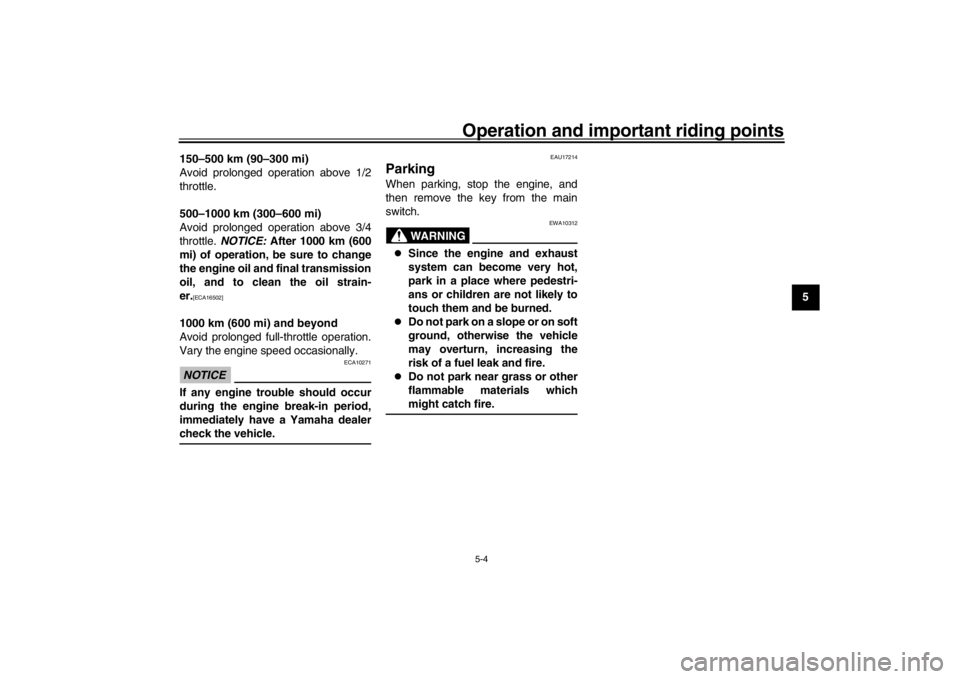
Operation and important riding points
5-4
1
2
3
456
7
8
9
10
11
12
150–500 km (90–300 mi)
Avoid prolonged operation above 1/2
throttle.
500–1000 km (300–600 mi)
Avoid prolonged operation above 3/4
throttle.
NOTICE: After 1000 km (600
mi) of operation, be sure to change
the engine oil and final transmission
oil, and to clean the oil strain-
er.
[ECA16502]
1000 km (600 mi) and beyond
Avoid prolonged full-throttle operation.
Vary the engine speed occasionally.NOTICE
ECA10271
If any engine trouble should occur
during the engine break-in period,
immediately have a Yamaha dealercheck the vehicle.
EAU17214
ParkingWhen parking, stop the engine, and
then remove the key from the main
switch.
WARNING
EWA10312
Since the engine and exhaust
system can become very hot,
park in a place where pedestri-
ans or children are not likely to
touch them and be burned.
Do not park on a slope or on soft
ground, otherwise the vehicle
may overturn, increasing the
risk of a fuel leak and fire.
Do not park near grass or other
flammable materials whichmight catch fire.
U53BE1E0 4 ページ 2015年9月15日 火曜日 午後1時48分
Page 36 of 84
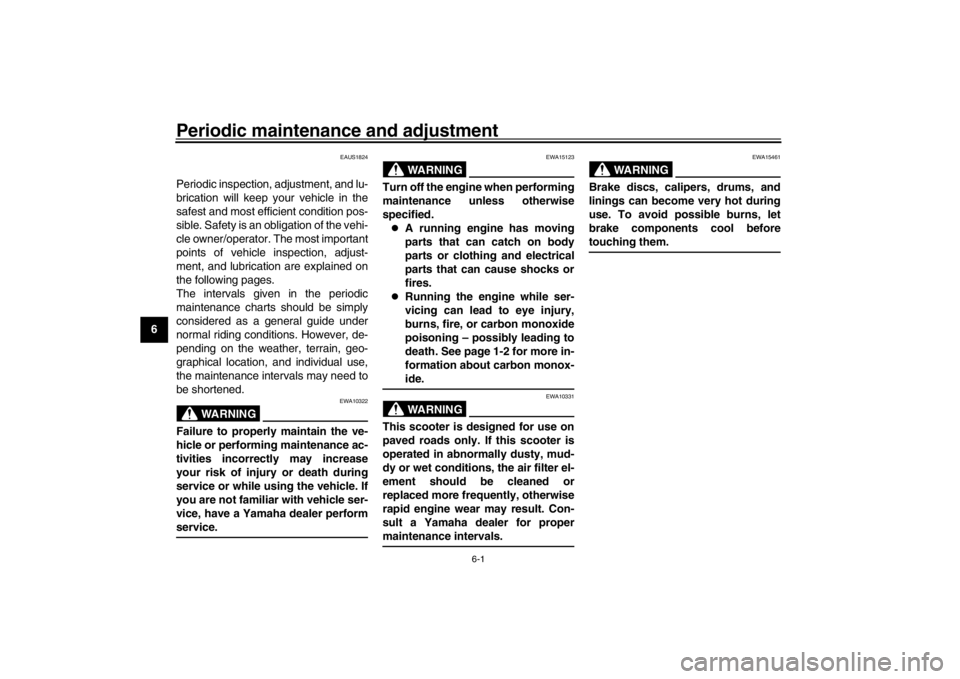
6-1
1
2
3
4
56
7
8
9
10
11
12
Periodic maintenance and adjustment
EAUS1824
Periodic inspection, adjustment, and lu-
brication will keep your vehicle in the
safest and most efficient condition pos-
sible. Safety is an obligation of the vehi-
cle owner/operator. The most important
points of vehicle inspection, adjust-
ment, and lubrication are explained on
the following pages.
The intervals given in the periodic
maintenance charts should be simply
considered as a general guide under
normal riding conditions. However, de-
pending on the weather, terrain, geo-
graphical location, and individual use,
the maintenance intervals may need to
be shortened.
WARNING
EWA10322
Failure to properly maintain the ve-
hicle or performing maintenance ac-
tivities incorrectly may increase
your risk of injury or death during
service or while using the vehicle. If
you are not familiar with vehicle ser-
vice, have a Yamaha dealer performservice.
WARNING
EWA15123
Turn off the engine when performing
maintenance unless otherwise
specified.
A running engine has moving
parts that can catch on body
parts or clothing and electrical
parts that can cause shocks or
fires.
Running the engine while ser-
vicing can lead to eye injury,
burns, fire, or carbon monoxide
poisoning – possibly leading to
death. See page 1-2 for more in-
formation about carbon monox-ide.WARNING
EWA10331
This scooter is designed for use on
paved roads only. If this scooter is
operated in abnormally dusty, mud-
dy or wet conditions, the air filter el-
ement should be cleaned or
replaced more frequently, otherwise
rapid engine wear may result. Con-
sult a Yamaha dealer for propermaintenance intervals.
WARNING
EWA15461
Brake discs, calipers, drums, and
linings can become very hot during
use. To avoid possible burns, let
brake components cool beforetouching them.
U53BE1E0 1 ページ 2015年9月15日 火曜日 午後1時48分
Page 37 of 84
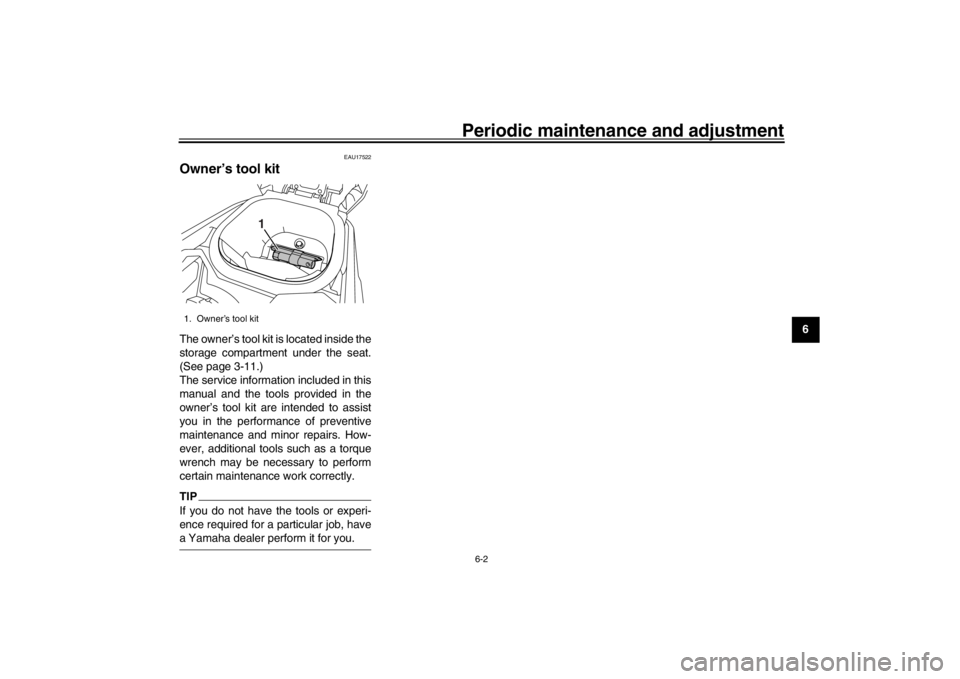
Periodic maintenance and adjustment
6-2
1
2
3
4
567
8
9
10
11
12
EAU17522
Owner’s tool kitThe owner’s tool kit is located inside the
storage compartment under the seat.
(See page 3-11.)
The service information included in this
manual and the tools provided in the
owner’s tool kit are intended to assist
you in the performance of preventive
maintenance and minor repairs. How-
ever, additional tools such as a torque
wrench may be necessary to perform
certain maintenance work correctly.TIPIf you do not have the tools or experi-
ence required for a particular job, havea Yamaha dealer perform it for you.1. Owner’s tool kit
1
U53BE1E0 2 ページ 2015年9月15日 火曜日 午後1時48分
Page 38 of 84

Periodic maintenance and adjustment
6-3
1
2
3
4
56
7
8
9
10
11
12
EAU46872
TIP
The annual checks must be performed every year, except if a kilometer-based maintenance, or for the UK, a
mileage-based maintenance, is performed instead.
From 30000 km (17500 mi), repeat the maintenance intervals starting from 6000 km (3500 mi).
Items marked with an asterisk should be performed by a Yamaha dealer as they require special tools, data and technicalskills.
U53BE1E0 3 ページ 2015年9月15日 火曜日 午後1時48分
Page 39 of 84

Periodic maintenance and adjustment
6-4
1
2
3
4
567
8
9
10
11
12
EAU46921
Periodic maintenance chart fo r the emission control systemNO. ITEM CHECK OR MAINTENANCE JOB ODOMETER READING
ANNUAL
CHECK
1000 km
(600 mi) 6000 km
(3500 mi) 12000 km
(7000 mi) 18000 km
(10500 mi) 24000 km
(14000 mi)
1 * Fuel line Check fuel hoses for cracks or
damage.
2 Spark plug Check condition.
Clean and regap.
Replace.
3 * Valves Check valve clearance.
Adjust.
4 * Fuel injection Check engine idle speed.
5 * Exhaust system Check for leakage.
Tighten if necessary.
Replace gasket(s) if necessary.
U53BE1E0 4 ページ 2015年9月15日 火曜日 午後1時48分
Page 40 of 84

Periodic maintenance and adjustment
6-5
1
2
3
4
56
7
8
9
10
11
12
EAU1771A
General maintenance and lubrication chartNO. ITEM CHECK OR MAINTENANCE JOB ODOMETER READING
ANNUAL
CHECK
1000 km
(600 mi) 6000 km
(3500 mi) 12000 km
(7000 mi) 18000 km
(10500 mi) 24000 km
(14000 mi)
1 Air filter element
2 Air filter check hose Clean.
3 V-belt case air filter
element Clean.
4 * Front brake Check operation, fluid level and
vehicle for fluid leakage.
Replace brake pads. Whenever worn to the limit
5 * Rear brake Check operation and adjust brake
lever free play.
Replace brake shoes. Whenever worn to the limit
6 * Brake hose Check for cracks or damage.
Check for correct routing and
clamping.
Replace. Every 4 years
7 * Wheels Check runout and for damage.
8 *Tires Check tread depth and for
damage.
Replace if necessary.
Check air pressure.
Correct if necessary.
9 * Wheel bearings Check bearings for looseness or
damage.
10 * Steering bearings Check bearing play and steering
for roughness.
Lubricate with lithium-soap-based grease. Every 50000 km (30000 mi)
11 * Chassis fasteners Make sure that all nuts, bolts and
screws are properly tightened.
U53BE1E0 5 ページ 2015年9月15日 火曜日 午後1時48分